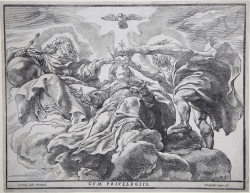



| Reference: | S17259 |
| Author | Christoffel JEGHER |
| Year: | 1633 |
| Measures: | 440 x 330 mm |


| Reference: | S17259 |
| Author | Christoffel JEGHER |
| Year: | 1633 |
| Measures: | 440 x 330 mm |
The Coronation of the Virgin; the Virgin is crowned by God the Father holding an orb and a sceptre, Christ at right, the Holy Spirit hovering above; on clouds view da sotto in su; after Peter Paul Rubens, 1633.
Monogrammed within image, in lower left: "C.I.". Lettered in lower margin: "P.P.Rub. delin. & excud" and "CUM PRIVILEGIIS.' and "Christoffel Iegher. sc.".
From 1625 on, Christoffel Jegher worked as an xylographer in the printing house run by Christophe Plantin in Antwerp. He produced book illustrations, ornaments and woodcuts with Christian religious themes. In 1627-1628 Jegher was admitted to the Antwerp Guild of St. Luke as a wood engraver.
Having realized the potential profits to be made from reproductive prints of his work, Rubens began to engage printmakers from 1619 onward. In the early 1630s, he turned to woodcuts in close collaboration with Christoffel Jegher. Indeed, Jegher's place in art history as the most important woodcutter of his time rests exclusively on the nine large single-page woodcuts that resulted from this collaboration.
In 1630, he was present in the workshop of Peter Paul Rubens as a wood engraver and from 1633 onwards, the collaboration between Rubens and Jegher intensified, and Jegher's style of wood engraving several important works that the Flemish master intended to publish changed profoundly. Done under the watchful eye of the latter, they are executed with great virtuosity and create the illusion of pen-and-ink drawing.
A good impression of the first state, published by Rubens himself, with margins, showing trace of central fold, generally in good conditions.
Bibliografia
Schneevoogt 1873 / Catalogue des estampes gravées d'après P.P.Rubens (79.40); Hollstein / Dutch and Flemish etchings, engravings and woodcuts c.1450-1700 (10.I); Le Blanc 8, Hollstein 10; Bodart, Rubens e l’incisione 153.
Christoffel JEGHER (Anversa 1596 - 1652/53)
|
Christoffel Jegher or Christophe Jegher, born around 1596 and died around 1652, was a Flemish engraver, whose family originated from the province of Silesia, and who was active in Antwerp in the 17th century.
From 1625 on, Christoffel Jegher worked as an xylographer in the printing house run by Christophe Plantin in Antwerp. He produced book illustrations, ornaments and woodcuts with Christian religious themes.
In 1627-1628 Jegher was admitted to the Antwerp Guild of St. Luke as a wood engraver. It is assumed that he imitated the style of Christoffel van Sichem the Elder. In 1630, he was present in the workshop of Peter Paul Rubens as a wood engraver and from 1633 onwards, the collaboration between Rubens and Jegher intensified, and Jegher's style of wood engraving several important works that the Flemish master intended to publish changed profoundly. Done under the watchful eye of the latter, they are executed with great virtuosity and create the illusion of pen-and-ink drawing.
From 1630 on, Christoffel Jegher also produced a series of woodcuts based on drawings by Erasmus Quellinus and Frans Francken I. His son Jan Christoffel Jegher continued the tradition and engraved works by Antoine Sallaert.
|
Christoffel JEGHER (Anversa 1596 - 1652/53)
|
Christoffel Jegher or Christophe Jegher, born around 1596 and died around 1652, was a Flemish engraver, whose family originated from the province of Silesia, and who was active in Antwerp in the 17th century.
From 1625 on, Christoffel Jegher worked as an xylographer in the printing house run by Christophe Plantin in Antwerp. He produced book illustrations, ornaments and woodcuts with Christian religious themes.
In 1627-1628 Jegher was admitted to the Antwerp Guild of St. Luke as a wood engraver. It is assumed that he imitated the style of Christoffel van Sichem the Elder. In 1630, he was present in the workshop of Peter Paul Rubens as a wood engraver and from 1633 onwards, the collaboration between Rubens and Jegher intensified, and Jegher's style of wood engraving several important works that the Flemish master intended to publish changed profoundly. Done under the watchful eye of the latter, they are executed with great virtuosity and create the illusion of pen-and-ink drawing.
From 1630 on, Christoffel Jegher also produced a series of woodcuts based on drawings by Erasmus Quellinus and Frans Francken I. His son Jan Christoffel Jegher continued the tradition and engraved works by Antoine Sallaert.
|